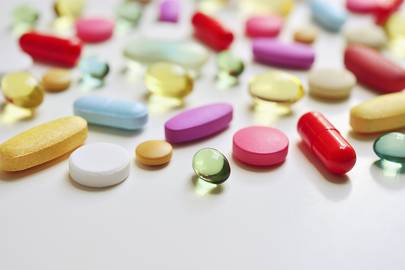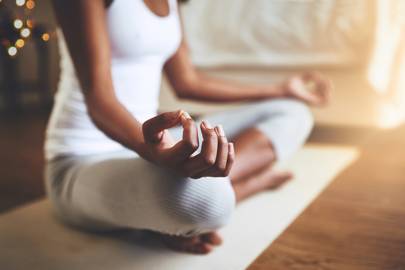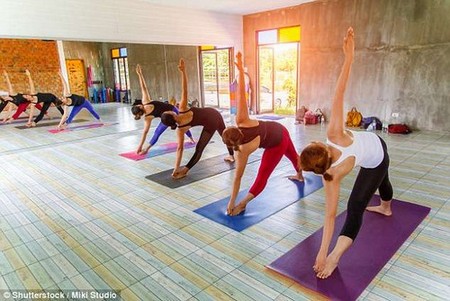Whether it’s the keto, vegan or the Dubrow, there’s a plethora of wellness and diet plans for people to follow but how do you know which is the best one for your own personal wellness goals?
One wellness plan that seems to tick all the boxes (in our humble opinion) is the anti-inflammatory lifestyle, which experts claim can give you glowier skin, enhanced health and a much better life.
One expert who is so convinced by the positive effects of this lifestyle is award-winning Swedish science journalist and author, Maria Borelius. Maria, who has a degree in biology, physics and mathematics and a master’s degree in science journalism, is so enamoured by the anti-inflammatory lifestyle that she penned an entire book about it.
Health Revolution is the incredible story of one Maria’s quest to banish depression and fatigue, boost her energy and live a healthier, happier life.
Bringing together ground-breaking research from across the globe, the ancient wisdom of Ayurveda and a lifetime of experimentation, this book presents a simple five-step plan to bring out the best version of you. Maria promises that readers will look younger, and more importantly, feel way better.

We have scientific proof that inflammation drives illness and that anti-inflammation measures not only counteract disease, but also strengthen everyday health in a powerful way. We see the evidence from the Blue Zones, from research in Lund, from the epigenetic frontline, from awe research, and a number of other things.
I can only summarize it like this: In my opinion, the anti-inflammatory journey is a journey toward your best self, a body and soul in balance, a feeling of harmony and alertness.
Let me also say this:
- The anti-inflammatory journey is not a happy pill, but you do become happier and more mentally stable.
- It isn’t a doctor’s visit, but central health factors are optimized.
- It isn’t a diet, but body weight is stabilized and the body feels streamlined and strong.
- It isn’t a beauty cure, but the skin gets new luster and strength, and fewer wrinkles.
- It isn’t an intelligence cure, but you sharpen your ability to think and your working memory.
We remain ourselves, but in our very best version.
How can we achieve this? How can you put together an anti-inflammatory lifestyle?
Boost your system with anti-inflammatory foods: Every day, eat plenty of good, natural food, polyphenols, omega-3, and probiotics.
Lower sugar intake: Every day, spare the body from too much sugar and too many carbohydrates, and reduce the glycemic response to the sugar that you do eat.
In motion: Give yourself the chance to exercise every day.
Stillness: Give yourself peace, calm, and conscious rest every day.
Seek out awe: Be curious about how to find your awe, and allow yourself to experience great and divine moments.
Those are five points, whose initials, through a small miracle, form the word BLISS.
The path to bliss is simple, but requires a new consciousness. It involves a kind of updated version of pre-human Lucy’s lifestyle, which deeply respects our human roots, but also involves adaptation, since we no longer live on an African savannah, but in a modern society with completely different frameworks. Through this lifestyle, we can find our way back to ourselves, although with new eyes.
Here I’ll go over the principles that combine to form an anti-inflammatory lifestyle – the path to bliss.
THE BLISS PRINCIPLES
1. Boost with anti-inflammatory food
The value of real food. More polyphenols. More omega-3. Increase probiotics.
Food is meant to provide health, joy, strength, and enjoyment. Just as Lucy did, choose food that nature has created, as close to its natural form as possible. In keeping with the slogan “made by nature, not by man”, I’d rather eat a tomato than a prepared tomato sauce, rather an orange than juice, rather grilled meat and potatoes than prepared hash. Any pre-made, processed food with more than five ingredients should be regarded with some suspicion.
Eat real, homemade food. Not weak salads that leave you vulnerable to a blood sugar crash in the afternoon, but “regular” food that’s boosted with anti-inflammatory tricks.
Eat more vegetables of all kinds, preferably four different kinds with four different colors.
Eat a rainbow of vegetables and berries every day. Blueberries, purple eggplant and red onion, green spinach, yellow peppers, orange carrots, red tomatoes, and all other colors. Vegetables, with their various polyphenols, act directly or indirectly (researchers are investigating this) as protective mechanisms for the plants, and we humans can “borrow” their effects to protect ourselves.
Eat plenty of protein at every meal: poultry, eggs, lentils, meat, fish, or protein power, which builds up cells, connective tissues, and muscles.
Eat plenty of fats, which give the body energy and enhance the taste of food. Oils like olive oil, rapeseed oil, coconut oil, avocado oil, and sometimes organic butter are good. But avoid margarine, sunflower seed oil, and hydrogenated vegetable fats in cookies, chips, and industrially prepared food.
Use spices, and use them with abandon; find new combinations. I like thyme and garlic, turmeric and paprika, coriander and cumin, chili and mint, ginger and lemon.
In general: add turmeric to everything! Our pots and pans at home are yellow from all the turmeric I use when I cook vegetables and when I saute chicken, salmon, and steaks in coconut oil and turmeric to get a nice finish.
Love your tea. All kinds – black, green, red… Use a variety of different herbal teas every day.
Coffee contains polyphenols, but also activates blood sugar. Compromise by having one cup a day.
Be careful with alcohol, but a glass of red wine can be taken since it a) gives pleasure, and b) contains the polyphenol resveratrol, which research has shown to be anti-inflammatory. Try to choose a red wine with a strong, slightly harsh taste, like pinot noir wines, which have the highest levels of resveratrol.
Eat omega-3 every day. Regardless of whether you eat fatty fish several times a week, take omega-3 in capsule form or get your daily dose from little chia seeds in a chia pudding that’s been allowed to soak overnight in a glass of almond milk; you will soon notice how this fortifies everything from your mood to your skin.
If you’re at the restaurant and don’t know what to choose, go for fatty fish and vegetables. That’s the new basic food.
Grow your inner gut flora. (Hi there, bacteria!) Eat lots of greens, and also boost every day with a probiotic tablet, switching out the type of bacteria when you’ve used up the old jar. You want to expose yourself to many different kinds of good bacteria. Also eat extra yogurt or kefir every day. Experiment with kombucha, and choose some different kinds, like ginger, or turmeric. I like to eat a mini bowl of fermented vegetables at dinner also, but that may not be for everyone.
2. Lower sugar intake
Keep sugar levels down. Eat better, complex carbohydrates. Decrease the GI-response.
Carbohydrates are a complicated subject, I’ve learned. From gummy raspberries to pasta carbonara – what’s the best strategy?
There are two main goals. To decrease the amount of simple sugars by eating better carbohydrates and in smaller amounts, and to moderate how the body responds to sugar. This is to keep down the quick sugar peaks that are the body’s enemy since they directly drive inflammation.
Converted to everyday strategies, this means something like the following:
Plan for long and even satiety. And plan ahead so you won’t end up with panic and stress. The planning doesn’t take more time, but I’ve learned that it’s another type of time, more “ahead time” than “panic time”. Which in turn gives better food quality.
A first step is to get rid of all the sugary junk in the refrigerator, freezer, and pantry. Out with marmalade, ice cream, cookies, sodas, and such, so that it will be harder to satisfy hunger with a sugar fix.
Another method is to figure out a new standard breakfast, which will probably be different from the way you used to eat. Breakfast buffets with bread, orange juice, sugary fruit yogurt, “regular” high-lactose milk, processed cereal, and marmalade – goodbye! Many of these products will give you a blood sugar rush or create other types of inflammation. Bread, even if it’s wholegrain, contains heavy gluten proteins that can give rise to low-grade inflammation. (In my new existence, I have an occasional slice of bread here and there, maybe a Danish rye bread or sourdough bread, where bacteria have broken down some of the gluten proteins in advance.) Juice contains as much as several teaspoons of sugar, without the fiber that naturally exists in fruit pulp and skins, lowering the sugar response when you eat whole fruits.
The new breakfast instead focuses on protein, fat, vegetables, and fruit. A smoothie with almond milk, fruit, nuts, and protein powder. A bowl of yogurt with nuts, seeds, and berries. Scrambled eggs and rice cakes. Or a bowl of oatmeal with seeds and maybe an egg.
The strategy is to choose fresh fruits and berries, and in the category of complex carbohydrates, unprocessed products like sweet potatoes, brown rice, rice cakes, quinoa, and oats are your friends. And eat the carbohydrates along with fat and protein!
I’ve decreased the amount of carbohydrates since I want to keep my insulin content low and even, but at the same time, body and brain need the energy that carbohydrates can give. Here you have to experiment to find the right level for you. One strategy might be to only eat complex carbohydrates in one bigger meal per day; for example, the one you eat right after exercising. In my case, that doesn’t work. If I don’t get complex carbohydrates at dinner, I can’t sleep at night.

I’ve also learned to eat the food on my plate a little differently. Now I always begin the meal with proteins, vegetables, and fats, and eat the complex carbohydrates, like sweet potato and quinoa, in the later part of the meal. That makes the insulin level rise more gradual, and satiety is signaled via the foods that are least inflammation-driving. If a meal consists of chicken, grilled vegetables, salad, and brown rice, you should eat it in this order: first vegetables and chicken, then the brown rice at the end. I no longer eat a big plate of pasta with a little sauce, but have changed the proportions so that I have lots of vegetables, lots of meat sauce, and a smaller amount of pasta (preferably gluten free).
Read the list of contents and zoom in on the heading “carbohydrates”, under which the sugar content is listed by itself as a subheading. Breakfast cereal with 25 percent sugar is candy, not food.
When it comes to lessening the glycemic response to a meal, there are two good, scientifically proven tricks: vinegar and soluble viscous fibers. You can take advantage of this by using vinegar in a salad before the meal, in the French style. Or take in more of the soluble fibers in vegetables, berries, beans, brown rice, figs, flaxseed, and sunflower seeds. These tricks will help you slow down your blood sugar increase after a meal, which is exactly what we want.
Snacks can be a challenge. Instead of sweet rolls and coffee, choose something more satisfying, like a bowl of Greek yogurt with chia seeds, two boiled eggs with a tomato, or a juicy red apple with nuts. Or try making exciting little energy balls at home in the mixer using coconut oil, dates and berries, that you can take with you and pass out to fellow humans who may need it.
Personally, I’m skeptical about all the juicing. Pure fruit juice pushes insulin the way a racecar driver pushes down on the gas pedal, which ultimately drives inflammation. If you’re going to juice, green juices are best, preferably with some added nuts, whose fat gives a slower blood sugar rise. The very best smoothies are the ones that combine juice with protein and fat, and for example contain nuts.
But if I get an irresistible sugar craving and eat half a box of chocolates a couple of times a year, I accept it with calmness. That’s what happens if you put my inner Lucy next to a box of chocolates on a gray Thursday evening in November. Time to shrug your shoulders and continue the bliss-cure.
How do you eat when on your own? ?Before my change into an antiinflammatory diet my answer wld have been ’whatever’. ?Being a mum of 4, with a husband who also loves cooking, eating well was something I treated myself to with others, when it gave pleasure to others..on my own I would have drab toast, boring cereal, loads of icecream, a ready made tinned soup..dull, nutrient poor, carb rich stuff which. But then I decided I was worth beauty, health, taste also when alone, that nobody would ever look after my health and selfesteem if I didnt do it myself..? Either you live on your own full time, or just eat alone sometimes, ⭐️how do you celebrate your health, when eating alone? Anyway, today made dead simple dinner for one, super tasty and ticking all antiinflammatory boxes: ?charred cabbage w olive oil ?sweet potatoe chips w turmeric and smoked paprika ?salmon w tomatoe and dill ?hummous w coriander. And ze fermented sauerkraut. Because we are worth it!? #antiiflammatory @healthrevolution
A post shared by Maria Borelius (@maria.borelius) on Jun 11, 2019 at 12:46pm PDT
3. In motion
Every day, get some kind of exercise. Every week, do some aerobic exercise, muscle-strengthening exercise, and stretching.
Every opportunity for exercise decreases inflammation in the body. You need to exercise every day, but you can vary the type of exercise, according to the rhythm of the day, your schedule, or the demands of your family, job, and different events in your life.
Part of the puzzle is getting in some kind of regular aerobic exercise every week, something that makes you sweat. Biking, powerwalking, running, skiing, swimming, tennis… You also need to do strength training, either in a class setting or by yourself at the gym, so that you can seriously challenge the muscles. Finally, add some calm, stretching, relaxing type of exercise. The body needs all three: conditioning, muscles, and relaxation.
Many people talk about willpower, and I’ve come to see my workout sessions as my breathing, my lungs. But you can’t expect to always feel like exercising when you should. Exercise also needs to be planned, like everything else that’s important. Exercise that only happens when there’s spontaneous inspiration won’t become a lifelong habit. Instead, you can aim to exercise a little very day, but vary the length and intensity. And even when you don’t feel like it, you can at least try ten minutes. If it still feels hard, it may be time to take it easy. Usually, though, both motivation and enthusiasm will get going, with their endorphins and dopamine…
You can also eat strategically for exercise. That means that you arrange carbohydrate intake around workout sessions, along with proteins, to make sure that the carbohydrates are used to build muscles. Preferably eat an hour after exercise – protein and carbohydrates – so that the cortisol content will be decreased quickly. That will lessen the inflammatory effect of the cortisol and your muscles will get nourishment more quickly.
4. Stillness
Actively seek out opportunities to de-stress: meditation, yoga, mindfulness. Just be. Sleep.
The jigsaw puzzle of life is stressful for most of us, and that stress increases inflammation in the body through the stress hormone cortisol. If you want to live in an anti-inflammatory way, you need to plan for rest just as much as for activity.
A moment of deep breathing and meditation decreases inflammation. So take the time to breathe deeply, meditate, practice yoga; to just be, to actively train mindfulness. Nothing really means as much as we think, except for the truly big values in life, like love.
It’s also important to let the digestive system rest. Short periods of fasting decrease inflammation, and you might want to try some form of mini-fast every week. I don’t like going all day without any food at all, but have found that one or two days a week with 14:10 can feel very good. (That is, fourteen hours without food after the last meal of the evening. If I had dinner at seven I won’t eat breakfast until nine the next day.)
This rest and stillness also includes healing sleep, which in itself contains important repair mechanisms. Maximize your anti-inflammatory sleep by focusing on keeping cortisol to a minimum, and try to fall asleep before 11:00. That means giving yourself a little time to slow down, turning off the computer and TV, and staying away from the internet and all social media. All these screens vie for our brains and keep us revved up when we should actually be slowing down.
5. Seek out Awe
Allow yourself to stop and enjoy the beauty of life.
Now we’ve come to the awe research. Only you know what your awe looks like, but give yourself time to make a list of what feels big, holy, and beautiful to you. And give yourself permission to stop and take this in, to feel how your whole system slows down.
As I’ve worked on this book, people I’ve talked to have given me the following images that you might find inspiring:
· The most beautiful sunset over the ocean, where the sun becomes a glittering strip of light and you see sailboats out on the water.
· The untouched mountains with blue ski tracks, when the day comes to an end and you’re alone on the tracks.
· The quiet church at Christmastime, with its lit candles and its calm devotion.
· Holding a newborn child.
· Being able to say thank you to life, even when you have big problems.
· The artists in the Bloomsbury group and the art they created.
· Being able to sit and look at decorating tips on Pinterest and enjoy different pictures of tiles, colors, and fabrics.
· The light in a Rembrandt painting.
· The soundtrack to the Lord of the Rings films.
· Rachmaninoff’s Second Piano Concerto.
· Listening to Queen sing “We will rock you”.
· Helping a friend in need.
· A meeting at Amnesty where you save the world and fight for imprisoned dissenters along with likeminded people.
Find your own list, let it grow, use it, make a mood board with pictures, fill your Spotify list… Allow yourself to be passionate, look for your sacred spaces, and stop and take it all in.
Life is great. Thank you for letting me be here.
That’s what a bliss day might look like.
But what if it feels like too much, to take in everything at once?



